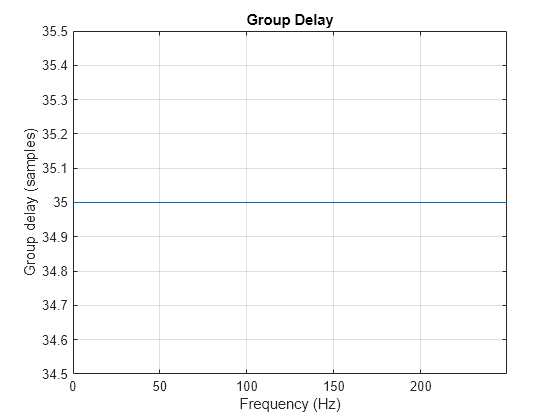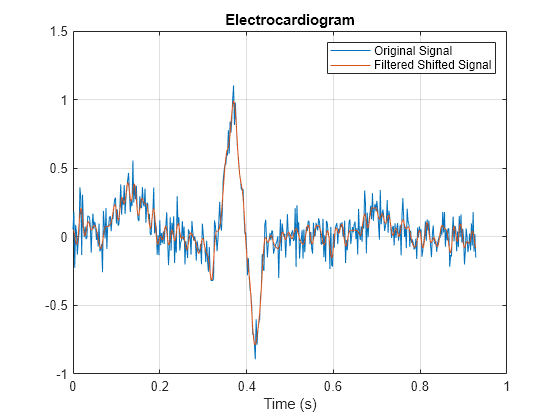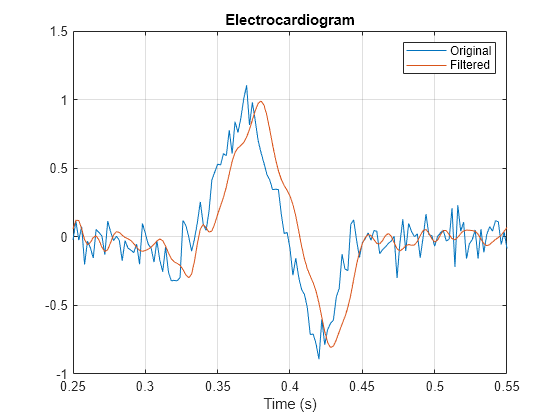필터로 인해 발생하는 지연과 왜곡 보정하기
신호를 필터링하면 지연이 발생합니다. 이는 출력 신호가 입력 신호에 비해 시간적으로 이동하는 것을 의미합니다.
이동 크기가 일정할 경우, 신호를 시간적으로 이동하여 지연을 해결할 수 있습니다.
때때로 필터는 특정 주파수 성분을 다른 주파수 성분보다 더 지연시킵니다. 이 현상을 위상 왜곡이라고 합니다. 이 영향을 보정하려면 filtfilt 함수를 사용하여 영위상 필터링을 수행할 수 있습니다.
1초 동안 500Hz로 샘플링된 심전도 측정값을 가져옵니다. 랜덤 잡음을 추가합니다. 재현 가능한 결과를 얻기 위해 난수 생성기를 재설정합니다.
Fs = 500;
N = 500;
rng default
xn = ecg(N)+0.1*randn([1 N]);
tn = (0:N-1)/Fs;75Hz가 넘는 주파수를 저지하는 필터를 사용하여 일부 잡음을 제거합니다. designfilt를 사용하여 차수가 70인 FIR 필터를 설계합니다.
Nfir = 70; Fst = 75; firf = designfilt('lowpassfir','FilterOrder',Nfir, ... 'CutoffFrequency',Fst,'SampleRate',Fs);
신호를 필터링한 다음 플로팅합니다. 결과로 생성된 신호는 원래 신호보다 매끄럽지만 뒤처져 있습니다.
xf = filter(firf,xn); plot(tn,xn,tn,xf) title 'Electrocardiogram' xlabel 'Time (s)' legend('Original','FIR Filtered') grid

grpdelay를 사용하여, 필터로 인한 지연이 필터 차수의 절반과 같은지 확인합니다.
grpdelay(firf,N,Fs)

delay = mean(grpdelay(firf))
delay = 35
데이터를 정렬합니다. 필터링된 신호의 처음 delay개 샘플을 제거하여 필터링된 신호를 이동시킵니다. 원래 신호와 시간 벡터의 마지막 delay개 샘플을 제거합니다.
tt = tn(1:end-delay); sn = xn(1:end-delay); sf = xf; sf(1:delay) = [];
신호를 플로팅하고 신호가 정렬되었는지 확인합니다.
plot(tt,sn,tt,sf) title 'Electrocardiogram' xlabel('Time (s)') legend('Original Signal','Filtered Shifted Signal') grid

7차 IIR 필터를 사용하여 계산을 반복합니다.
Niir = 7; iir = designfilt('lowpassiir','FilterOrder',Niir, ... 'HalfPowerFrequency',Fst,'SampleRate',Fs);
신호에 필터를 적용합니다. 필터링된 신호가 원래 신호보다 깨끗하지만, 원래 신호에 비해 시간상 뒤처져 있습니다. 또한 필터링된 신호는 필터의 비선형 위상으로 인해 왜곡되었습니다.
xfilter = filter(iir,xn); plot(tn,xn,tn,xfilter) title 'Electrocardiogram' xlabel 'Time (s)' legend('Original','Filtered') axis([0.25 0.55 -1 1.5]) grid

필터로 인한 군지연을 살펴보면 지연이 주파수 종속적임을 알 수 있습니다.
grpdelay(iir,N,Fs)

filtfilt를 사용하여 신호를 필터링합니다. 지연과 왜곡이 효과적으로 제거되었습니다. 신호의 위상 정보를 반드시 그대로 유지해야 하는 경우 filtfilt를 사용하십시오.
xfiltfilt = filtfilt(iir,xn); plot(tn,xn) hold on plot(tn,xfilter) plot(tn,xfiltfilt) title 'Electrocardiogram' xlabel 'Time (s)' legend('Original','''filter''','''filtfilt''') axis([0.25 0.55 -1 1.5]) grid
